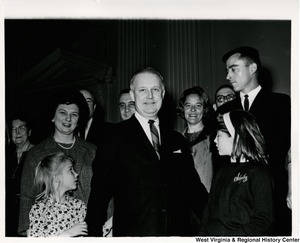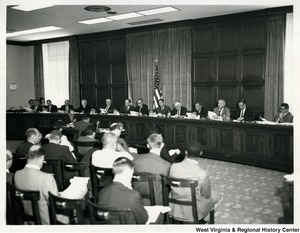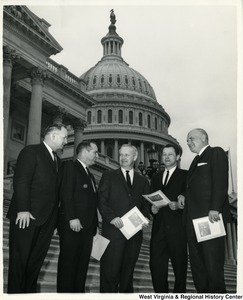Search Constraints
« Previous |
25 - 36 of 43
|
Next »
Search Results

- Identifier:
- am2862_moore_0650
- Title:
- Photograph of Reverend Dr. G. Ousley Brown shaking the hand of Reverend Dr. Bernard Braskamp
- Date:
- 1965
- Publisher:
- West Virginia & Regional History Center
- Subject Personal:
- Braskamp, Bernard, Reverend , Brown, G. Ousley, Reverend , and Moore, Arch A., Jr. (Arch Alfred), 1923-2015
- Subject Topical:
- Handshaking, Legislators--United States, Presbyterian Church, Priests, Chaplains, and Governors--West Virginia
- Subject Corporate:
- Cove United Presbyterian Church (Weirton, W. Va.)
- Location:
- United States Capitol (Washington, D.C.)

- Identifier:
- am2862_moore_0652
- Title:
- Photograph of Congressman Moore and his family
- Date:
- 1965
- Publisher:
- West Virginia & Regional History Center
- Subject Personal:
- Moore, Lucy, 1956-, Moore, Arch A., Jr. (Arch Alfred), 1923-2015, Capito, Shelley Moore, 1953-, and Moore, Sadie Shelley Riley, 1926–2014
- Subject Topical:
- Fathers and daughters, Legislators--United States, Husband and wife, Governors--West Virginia , Daughters, and Family

- Identifier:
- am2862_moore_0653
- Title:
- Photograph of Congressman Moore with his daughters
- Date:
- 1965
- Publisher:
- West Virginia & Regional History Center
- Subject Personal:
- Moore, Lucy, 1956-, Moore, Arch A., Jr. (Arch Alfred), 1923-2015, and Capito, Shelley Moore, 1953-
- Subject Topical:
- Fathers and daughters, Legislators--United States, Governors--West Virginia , Daughters, and Family

- Identifier:
- am2862_moore_0651
- Title:
- Photograph of Congressman Moore with an unidentified group
- Date:
- 1965
- Publisher:
- West Virginia & Regional History Center
- Subject Personal:
- Moore, Arch A., Jr. (Arch Alfred), 1923-2015
- Subject Topical:
- Small groups, Legislators--United States, and Governors--West Virginia
- Location:
- United States Capitol (Washington, D.C.)

- Identifier:
- am2862_moore_0654
- Title:
- Photograph of Congressman William M. McCulloch signing a document
- Date:
- 1965
- Publisher:
- West Virginia & Regional History Center
- Subject Personal:
- McCulloch, William M. (William Moore), 1901-1980 and Moore, Arch A., Jr. (Arch Alfred), 1923-2015
- Subject Topical:
- Signing statements (Legislation), Legislators--United States, Legislation, Governors--West Virginia , and Legislative bodies--Officials and employees

- Identifier:
- am2862_moore_0659
- Title:
- Photograph of Congressman Moore standing with four others
- Date:
- 1965
- Publisher:
- West Virginia & Regional History Center
- Subject Personal:
- Moore, Arch A., Jr. (Arch Alfred), 1923-2015
- Subject Topical:
- Small groups, Legislators--United States, and Governors--West Virginia

- Identifier:
- am2862_moore_0656
- Title:
- Photograph of Congressman Moore speaking at a podium
- Date:
- 1965
- Publisher:
- West Virginia & Regional History Center
- Subject Personal:
- Moore, Arch A., Jr. (Arch Alfred), 1923-2015
- Subject Topical:
- Speeches, addresses, etc, Legislators--United States, and Governors--West Virginia

- Identifier:
- am2862_moore_0660
- Title:
- Photograph of Congressman Moore and his family during a parade
- Date:
- 1965
- Publisher:
- West Virginia & Regional History Center
- Subject Personal:
- Moore, Lucy, 1956-, Moore, Arch A., Jr. (Arch Alfred), 1923-2015, Moore, Sadie Shelley Riley, 1926–2014, and Capito, Shelley Moore, 1953-
- Subject Topical:
- Parades, Plymouth automobile, Valiant automobile, Automobiles, Convertible, Legislators--United States, Husband and wife, Governors--West Virginia , Daughters, Family, and Vehicles

- Identifier:
- am2862_moore_0661
- Title:
- Photograph of Congressman Moore speaking during a meeting
- Date:
- 1965
- Publisher:
- West Virginia & Regional History Center
- Subject Personal:
- Moore, Arch A., Jr. (Arch Alfred), 1923-2015
- Subject Topical:
- Speeches, addresses, etc, Legislators--United States, Meetings, Governors--West Virginia , and Legislative bodies--Officials and employees

- Identifier:
- am2862_moore_0663
- Title:
- Photograph of Congressman Moore with an unidentified group of people
- Date:
- 1965
- Publisher:
- West Virginia & Regional History Center
- Subject Personal:
- Moore, Arch A., Jr. (Arch Alfred), 1923-2015
- Subject Topical:
- Legislators--United States, Men, Governors--West Virginia , and Women

- Identifier:
- am2862_moore_0662
- Title:
- Photograph of Congressman Moore talking to two unidentified men
- Date:
- 1965
- Publisher:
- West Virginia & Regional History Center
- Subject Personal:
- Moore, Arch A., Jr. (Arch Alfred), 1923-2015
- Subject Topical:
- Legislators--United States, Men, and Governors--West Virginia

- Identifier:
- am2862_moore_0664
- Title:
- Photograph of Congressman Moore, Robert E. Lee Hall, and G. Don Sullivan
- Date:
- 1965
- Publisher:
- West Virginia & Regional History Center
- Subject Personal:
- Sullivan, G. Don, Moore, Arch A., Jr. (Arch Alfred), 1923-2015, and Hall, Robert E. Lee
- Subject Topical:
- Coal, Legislators--United States, Coal mines and mining, Legislation, Governors--West Virginia , and Coal miners--West Virginia
- Subject Corporate:
- National Coal Association
- Location:
- United States Capitol (Washington, D.C.)











